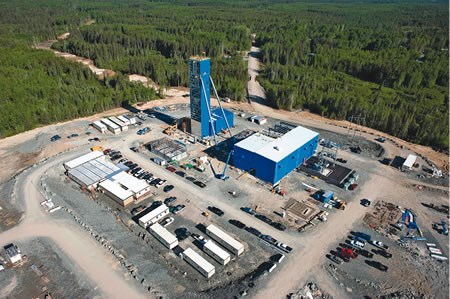With the shine of gold glittering across its Timmins-area properties, Lake Shore Gold Corp. is looking to transform itself from a mining junior to the next big mid-tier producer.
"We've got all the legs on the stool," says Tony Makuch, company president and CEO. "The Timmins properties are going to be a good foundation for moving us into that position."
Having recently signed a strategic alliance with German mining producer Hochschild Mining plc, Lake Shore is moving into a position of one day being able to pursue mergers and acquisitions with other firms to enhance its strength, Makuch says.
Hochschild has also stuffed Lake Shore's coffers, having spent $165 million in recent months to snap up 40 per cent of the company.
The company is in the rare position of being one of a few juniors with sufficient capital to pursue its many on-the-ground projects, at a time when the United States' credit crunch has made it difficult to acquire funds privately, Makuch says.
Approximately 90 per cent of this projected investment is also expected to be poured directly into northeastern Ontario, with the intention of spending $75 million on development and exploration in 2008 and as much as $100 million in 2009.
It is also projected to employ 140 people over the coming year and as many as 750 people within the next five years.
Much of this optimism stems from the prospects of putting four of Lake Shore's Timmins-area properties into production, including the Timmins West site, where production is expected to begin in 2009.
Other production hopefuls include the Bell Creek Complex, which includes the Bell Creek Mine, Schumacher and Vogel properties.
These would help to act as feed for Lake Shore's Bell Creek mine and mill, recently acquired from Goldcorp Canada Ltd. and Kinross Gold Corporation, and slated for re-opening by the end of the year.
The mill currently has the initial capacity to handle 800-tons per day, but can be expanded to 1,500-tons per day to help handle additional feed in the short term. Internal studies have shown the mill can be expanded even further, with the possibility of reaching as high as 2,500-tons per day within five years.
Close attention is being paid to the Bell Creek Complex, where plans are in place to take a second look at the former producing Bell Creek mine. The Vogel property is also being given consideration, though there remains some technical challenges in accessing it, such as overburden and swampy terrain.
Nevertheless, Makuch says the potential is there, as there are historical resources, and what he says to be some good near-term production potential. A ramp portal and culvert are expected to be constructed on the property by mid-2009.
However, the immediate focus will be on Timmins West on the opposite end of the camp, where a 2007 industry-compliant reserve estimate found 1.2 million ounces. It also features an indicated resource of 1,291,000 ounces averaging 12.29 g/t of gold, and an inferred resource of 207,000 ounces averaging 5.79 g/t of gold.
Working with the Wabun Tribal Council to create partnerships on its Timmins West complex, Lake Shore Gold is anticipating an 11-year mine life. However, continued exploration and the expected development of its other local properties might push the long-term estimate to 50 years and beyond, Makuch says. Many of the properties have been largely unexplored at depth.
In fact, while the company will produce 30,000 ounces through 2009, that total may well increase to 200,000 ounces by 2011. In total, the company will spend approximately $12 million on exploration per year for the next two years.
This includes the use of a fleet of six to eight drill rigs, which will be shared between the various properties. Two will be used on the Timmins West and Thunder Creek
properties. Three will be used on the Bell Creek Complex, two on the TPK project, and one shared between the nearby Casa Berardi and Blakelock properties.
"We've got the expertise, we've got the properties, we've got a great mining area, and we've got the results," Makuch says. "We can only go up from here."




